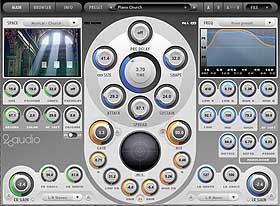
Aether’s well-organized GUI offers deep and completely independent control over early and late reflections.
I’ve been a big fan of 2CAudio’s Aether algorithmic reverb since its introduction last year. Version 1.5 boasts improved sound quality and terrific new features, and is a free update for owners of previous versions. I reviewed the AU version of Aether 1.5 in Digital Performer V. 6.02 using an 8-core Mac Pro running Mac OS 10.5.4. The plug-in is also available in VST format (it’s a 64-bit native Windows plug-in); an RTAS version is forthcoming.
HOW HIGH CAN YOU GO?
To satisfy even the most persnickety audiophile, the latency-free Aether 1.5 offers 64-bit internal operation and lets you choose from multiple levels of oversampling and modulation and interpolation quality. The result is more than 144 dB of noise and alias suppression at the highest quality settings. Aether supports mono-to-stereo, L/R stereo and M/S modes of operation, and you can use different modes simultaneously for its early (discrete) and late (diffuse) reflections. M/S processing allows, for example, adding reverb to only the mid or side channel of a completed mix, a mastering application.
The well-organized GUI offers dozens of parameter controls. Begin by tweaking the gain, wet/dry mix and various filters (shelving, HPF and LPF) for the input signal. Then choose one of 33 Space presets from a pop-up menu to load a patch of early reflections (ERs). Controls in the GUI’s ER section give you the ability to change the size, complexity of shape, timbral coloration and damping to construct your own virtual spaces.
Independent controls for Aether’s late reflections (LRs) adjust the size, shape, pre-delay, decay time, diffusion, attack, sustain, spread (echo-like ripples), HF shelving cut, LFO modulation and 3-band damping for the diffuse reverb tail.ERs and LRs can be chained in parallel, series or both ways at once in varying proportions. ERs and LRs can be independently bypassed. For example, bypassing the LRs can fashion a complex ambience patch devoid of any reverb tail.
USING PRESETS
A Frequency Profile menu offers a choice of 100 presets that recall settings for 15 filter controls at once. This streamlines the editing process and you can store your own frequency profiles and custom presets. Aether makes the comparison of presets easy. From the new browser page, you can audition presets while locking controls for wet/dry mix; input, ER and LR gains; size; and RT60 (decay time) to whatever values you deem appropriate for your current production. On the main page of the plug-in’s GUI, you can also lock the bypass state and input mode (mono, true stereo or M/S) independently for the ER and LR sections so they don’t change while you browse presets. And if the roughly 200 stock presets aren’t enough, 2CAudio offers its excellent Integrity and Creativity Expansion packs, each of which provides some 150 additional presets.
GIVE ME SPACE
Using Aether’s highest-quality modulation setting and enabling 4x oversampling, the sound quality went from great to superb yet demanded only about 5 percent of my Mac Pro’s resources with a single instantiation.
Aether sounded outstanding on drums. After loading the Studio ER pattern in the Space menu, dialing in moderate size and decay-time values for the LRs, and cranking the diffusion and sustain, the sound was ultra-smooth, realistic, detailed and 3-D. I was disappointed that Aether does not provide gated-reverb programs, an inexplicable oversight for an algorithmic reverb plug-in.
Muting LRs and riding the gain on “parking garage” ERs on select phrases of a lead vocal track lent a lush, wide automatic double-tracking effect that sounded fantastic. The Creativity Expansion pack’s Fathom preset—with its highly diffuse and nearly infinite reverb tail—transformed volume-pedal swells on an electric guitar track into a haunting celestial orchestra. Church and concert hall presets sounded realistic and gorgeous on piano. The inability to solo mid and side channels, however, made it difficult for me to get good results using Aether’s M/S modes in a mastering context.
Aether’s overall complexity imposes a fairly steep learning curve. But the extra effort is worth it. Aether offers world-class reverb at a great price.
Mix
contributing editor Michael Cooper owns Michael Cooper Recording in Sisters, Ore.

Click on the Product Summary box above to view the Aether product page.







